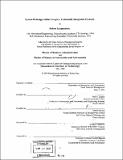System redesign within complex, technically integrated products
Author(s)
Giammatteo, Robert E. (Robert Eugene)
DownloadFull printable version (18.75Mb)
Alternative title
Redesign of SN-95 Mustang convertible water seal system
Other Contributors
Sloan School of Management.
Advisor
Paul A. Lagace and Arnold Barnett.
Terms of use
Metadata
Show full item recordAbstract
The process by which complex, technically integrated products are designed and introduced can be a source of competitive advantage, especially when marketplaces are sensitive to product quality levels. An extension of this competitive advantage is the process by which ongoing production programs are supported. The ongoing support of complex products involves periodic evaluation of critical systems that effect overall customer satisfaction with the product. Such evaluation is performed to identify systems whose performance has dropped to levels that require full system redesign. In this study, a methodology is proposed that can be utilized in the redesign process of systems embedded within complex products. The overall methodology involves identification of critical target systems, a failure mode analysis of the identified system(s), use of benchmarking and/or statistical tools as necessary to characterize features that can be utilized to improve system performance, and finally, conceptual design activity to implement such features. Specifics of each of the aforementioned process steps within the overall methodology are illustrated through work performed on a project sponsored by Ford Motor Company to address poor performance of the water seal system on the SN-95 Mustang convertible. In addition to the technical issues encountered during execution of the proposed system redesign methodology, organizational issues significantly impact the overall effectiveness of ongoing production program support. Organizational structures can raise barriers to efficient organizational knowledge transfer, thus introducing inefficiencies into the overall product development process. This study examines the relationship between organizational structure and knowledge flow amongst the various stakeholders of ongoing production programs. This relationship is used to characterize mechanisms that promote effective transfer, management, and growth of the product development knowledge base within an organization's overall product development community. Examples of mechanisms that were characterized as promoting effective knowledge transfer, management, and growth include the use of aligned organizational metrics against which the different stakeholders responsible for support of a specific program are judged, and rigorous use of a formal process for documentation of experience-based lessons-learned.
Description
Thesis (S.M.)--Massachusetts Institute of Technology, Dept. of Aeronautics and Astronautics; and, (M.B.A.)--Massachusetts Institute of Technology, Sloan School of Management, 2000. Also available online at the MIT Theses Online homepage <http://thesis.mit.edu>. Includes bibliographical references (p. 187).
Date issued
2000URI
http://theses.mit.edu/Dienst/UI/2.0/Describe/0018.mit.theses%2f2000-23http://hdl.handle.net/1721.1/9255
Department
Massachusetts Institute of Technology. Department of Aeronautics and Astronautics; Sloan School of ManagementPublisher
Massachusetts Institute of Technology
Keywords
Aeronautics and Astronautics., Sloan School of Management.